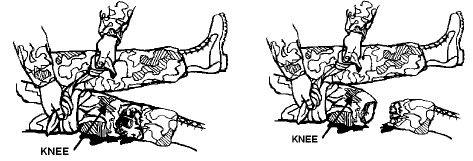Tourniquets
DANGER: A tourniquet is only used on an arm or leg where there is a danger of the casualty losing his life (bleeding to death).
A tourniquet is a constricting band placed around an arm or leg to control bleeding. A service member whose arm or leg has been completely amputated may not be bleeding when first discovered, but a tourniquet should be applied anyway. This absence of bleeding is due to the body’s normal defenses (contraction or clotting of blood vessels) as a result of the amputation, but after a period of time bleeding will start as the blood vessels relax or the clot may be knocked loose by moving the casualty. Bleeding from a major artery of the thigh, lower leg, or arm and bleeding from multiple arteries (which occurs in a traumatic amputation) may prove to be beyond control by manual pressure. If the pressure dressing under firm hand pressure becomes soaked with blood and the wound continues to bleed, apply a tourniquet.
WARNING Casualty should be continually monitored for development of conditions which may require the performance of necessary basic lifesaving measures, such as: clearing the airway, performing mouth-to-mouth resuscitation, preventing shock, and/or bleeding control. All open (or penetrating) wounds should be checked for a point of entry or exit and treated accordingly.
The tourniquet should not be used unless a pressure dressing has failed to stop the bleeding or an arm or leg has been cut off. On occasion, tourniquets have injured blood vessels and nerves. If left in place too long, a tourniquet can cause loss of an arm or leg. Once applied, it must stay in place, and the casualty must be taken to the nearest MTF as soon as possible. DO NOT loosen or release a tourniquet after it has been applied as release could precipitate bleeding and potentially lead to shock.
1. Improvising a Tourniquet. In the absence of a specially designed tourniquet, a tourniquet may be made from a strong, pliable material, such as gauze or muslin bandages, clothing, or cravats. An improvised tourniquet is used with a rigid stick-like object. To minimize skin damage, ensure that the improvised tourniquet is at least 2 inches wide.
WARNING The tourniquet must be easily identified or easily seen.
WARNING DO NOT use wire or shoestring for a tourniquet band.
2. Placing the Improvised Tourniquet
a. Place the tourniquet around the limb, between the wound and the body trunk (or between the wound and the heart). Never place it directly over a wound, a fracture, or joint. Tourniquets, for maximum effectiveness, should be placed on the upper arm or above the knee on the thigh

b. The tourniquet should be well-padded. If possible, place the tourniquet over the smoothed sleeve or trouser leg to prevent the skin from being pinched or twisted. If the tourniquet is long enough, wrap it around the limb several times, keeping the material as flat as possible. Damaging the skin may deprive the surgeon of skin required to cover an amputation. Protection of the skin also reduces pain.
2. Applying the Tourniquet.
a. Tie a half-knot. (A half-knot is the same as the first part of tying a shoe lace.)
b. Place a stick (or similar rigid object) on top of the half-knot

c. Tie a full knot over the stick

d. Twist the stick until the tourniquet is tight around the limb and/or the bright red bleeding has stopped. In the case of amputation, dark oozing blood may continue for a short time. This is the blood trapped in the area between the wound and tourniquet.

e. Fasten the tourniquet to the limb by looping the free ends of the tourniquet over the ends of the stick. Then bring the ends around the limb to prevent the stick from loosening. Tie them together on the side of the limb

NOTE Other methods of securing the stick may be used as long as the stick does not unwind and no further injury results.
NOTE If possible, save and transport any severed (amputated) limbs or body parts with (but out of sight of) the casualty.
f. DO NOT cover the tourniquet-you should leave it in full view. If the limb is missing (total amputation), apply a dressing to the stump. All wounds should have a dressing to protect the wound from contamination.
g. Mark the casualty’s forehead with a “T” and the time to indicate a tourniquet has been applied. If necessary, use the casualty’s blood to make this mark.
h. Check and treat for shock.
i. Seek medical aid.